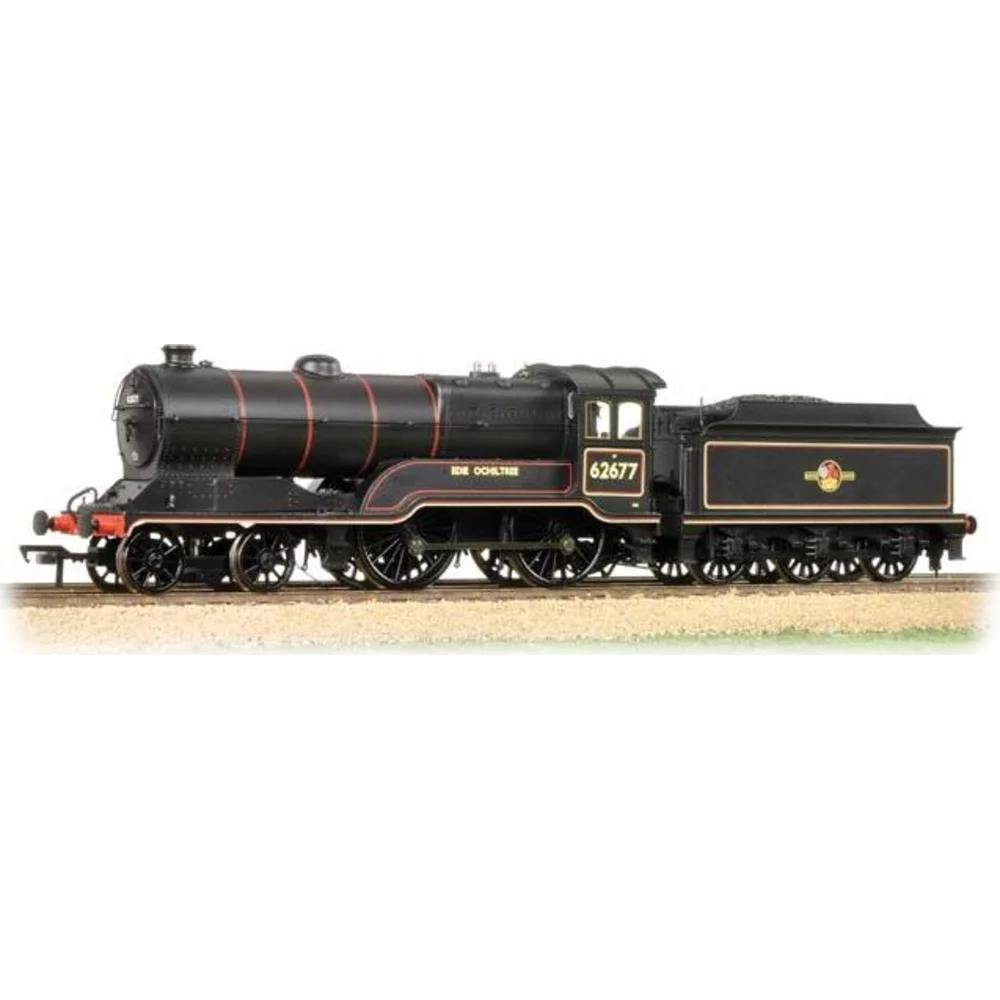Bachmann 31-136DC
London & North Eastern Railway D11/2 62677 Edie Ochiltree British Railways Lined Black with Late Crest
Tooling
In 2012, Bachmann Branchline introduced an all-new OO gauge tooling for the LNER Class D11 ‘Improved Director’ 4-4-0 locomotives. These models represented both the original Great Central Railway (GCR) D11/1 and the later North British Railway (NBR) D11/2 variants, which were adapted for the Scottish loading gauge. The prototype locomotives, designed by John G. Robinson, were among the most successful express passenger engines of their era, operating from 1919 until the early 1960s. Bachmann’s release filled a significant gap for pre-grouping and early LNER enthusiasts, offering a highly detailed and accurate representation of these iconic locomotives.
Tooling Features
- Scale: OO gauge (1:76).
- Construction: Precision-moulded plastic bodyshell with a mixed metal/plastic chassis for strength and weight.
- Detailing: Factory-fitted separate details including handrails, pipework, sanding gear, turned brass safety valves, smokebox door dart, and opening smokebox door. Fully detailed and painted cab interior with glazing.
- Couplings: NEM pockets with tension-lock couplers.
- Tender: Permanently coupled to the locomotive, housing the PCB and space for a speaker.
Mechanical & Electrical
- Motor & Drive: Smooth-running can motor
- Minimum Radius: Compatible with second radius curves (approx. 18 inches).
- Weighting: Metal components within boiler and chassis for improved adhesion.
- Lighting: No factory lighting fitted.
- Power Collection: 2-rail DC.
DCC Capability
- DCC Ready with a 21-pin socket located in the tender.
- Provision for a 28mm round speaker for sound installation.
- Popular upgrade options include Zimo MX644D decoders and IceCube speakers, with space for stay-alive capacitors.
Liveries Produced
The 2012 tooling has been released in a wide range of authentic liveries, including:
- GCR lined green (e.g., Butler Henderson).
- LNER green.
- LNER black (Scottish D11/2 variants).
- BR black with early emblem.
- BR black with late crest.
- Special editions such as BR apple green for collectors.
Reviews & Commentary
Model railway reviewers and enthusiasts have praised the Bachmann D11 for its fine detailing, smooth running, and accurate proportions. Video reviews highlight the model’s elegant appearance and reliable mechanism, with some noting its impressive size for a 4-4-0 design. Social media discussions generally regard the tooling as “one of Bachmann’s best pre-grouping releases,” though occasional comments mention the absence of factory lighting and the permanently coupled tender as minor drawbacks.
Interesting Notes
- The tender design allows for advanced sound installations, making it popular among DCC sound enthusiasts.
- The tooling was part of Bachmann’s strategy to test demand for Scottish prototypes before expanding the range.
Class & Prototype
- Class: London & North Eastern Railway D11/2
- Traction: Steam
- Built: 1919
- Total Built: -
- Running Number: 62677
- Name: Edie Ochiltree
The GCR Class 11F "Improved Director" was John G. Robinson's finest express passenger design—thirty-five 4-4-0 locomotives built 1919-1924 serving British railways for 42 years. Eleven D11/1 variants operated GCR express services from London Marylebone to Sheffield, whilst twenty-four D11/2 Scottish variants with restricted loading gauge profiles served former NBR routes, all bearing Sir Walter Scott character names. Inside admission piston valves distinguished them from earlier Directors, delivering 5% coal savings. Only No. 506 "Butler-Henderson" survives at Barrow Hill Engine Shed. Bachmann Branchline produces exceptional OO gauge models (rated 4.8/5) with accurate D11/1 and D11/2 tooling across multiple liveries including GCR lined green, LNER apple green/black, and BR lined black (£106-160).
Operator & Livery
- Operator: British Railways
- Livery: Lined Black with Late Crest
- Era: 5 - British Railways Late Crest
British Railways transformed Britain's fragmented rail network into a unified national system following nationalisation on 1st January 1948. Created from the "Big Four" companies under the Transport Act 1947, BR operated most of Great Britain's railways until rebranding as British Rail in 1965, managing over 20,000 route miles and inheriting nearly 20,000 locomotives of diverse designs.
The organisation pioneered standardisation through its revolutionary BR Standard locomotive programme (1951-1960), producing 999 advanced steam engines under Robert Riddles' direction. These included the versatile Britannia Pacifics, mighty 9F freight engines, and mixed-traffic classes that incorporated the best features from all predecessor companies. The 1955 Modernisation Plan accelerated diesel and electric traction development, creating fascinating mixed-traction operations.
Notable achievements included establishing unified locomotive classification systems, introducing distinctive corporate liveries, and managing the complex transition from steam to modern traction. BR's six regional structure preserved operational diversity whilst enabling standardisation of practices, signalling, and rolling stock that had eluded private enterprise for over a century.
The BR era represents steam traction's final flowering alongside emerging diesel technology, creating unparalleled locomotive variety. Today, this heritage remains highly popular with railway enthusiasts through extensive preserved fleets, heritage railway operations, and comprehensive model ranges from manufacturers like Hornby, Bachmann, and Dapol, making BR subjects essential for authentic post-war British railway modelling across all scales.
